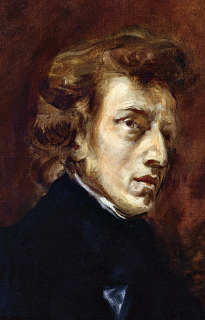Biography: Frédéric Chopin (1810–1849)

Chopin was born near Warsaw, where his father, a Frenchman who had emigrated to Poland and married a Polish lady, ran a private school for young gentlemen. In this atmosphere Fryderyk — later he adopted the French form Frédéric — acquired his lifelong taste for life in high society. Provided with the best teachers available, he became an extraordinary pianist. There are many reports of the exquisite delicacy of his playing, and his miraculous ability, as it seemed at the time, to draw romantic sounds out of the piano.
Furthermore, his set of variations on Mozart’s “Là ci darem la mano” (see page 192), written when he was seventeen, was already an impressive enough composition to earn a rave review from Robert Schumann.
Chopin settled in Paris, where he found ready acceptance from society people and from other artists and intellectuals, such as the novelist Honoré de Balzac and the painter Eugène Delacroix, who produced the famous portrait of the composer shown here. Chopin made his way as a fashionable piano teacher and by selling his music to publishers. The facts that he was Polish and that Poland was being overrun by Russia at that time seem to have made him even more glamorous to the French. Among Chopin’s piano miniatures are over fifty Mazurkas and sixteen Polonaises, which are stylized Polish dances.
Chopin was a frail and fastidious personality. Though he sometimes played in public, he truly disliked the hurly-
The major event of his personal life was his ten-
Chief Works: Character pieces for piano: Preludes (including the “Raindrop” prelude), Nocturnes, Études, Ballades, Waltzes (including the “Minute” waltz), and Polish Mazurkas and Polonaises ◼ Three piano sonatas, including one with a famous funeral march as the slow movement ◼ Two piano concertos ◼ A cello sonata; a few Polish songs
Encore: Listen to the Nocturne in D-
Image credit: Louvre, Paris, France/Giraudon/The Bridgeman Art Library.